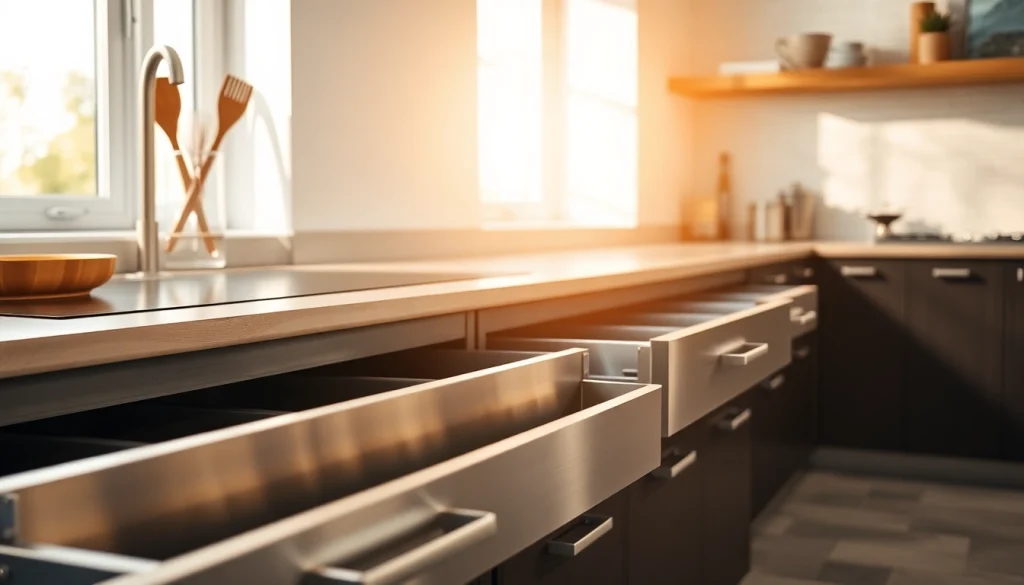Understanding the Metal Drawer System
What is a Metal Drawer System?
A metal drawer system is a storage solution made primarily from durable materials such as steel or aluminum. These systems are designed to provide a robust and reliable means of organizing items in various environments, from home kitchens to industrial settings. Unlike traditional wooden drawer systems, metal drawer systems offer increased resistance to wear and tear, providing longevity and durability.
The design of metal drawer systems can range from simple slides to complex mechanisms that include features like soft-close mechanisms and full-extension options. Their construction typically involves high-quality materials that are engineered to withstand heavy loads, making them ideal for both residential and commercial applications. If you’re looking to enhance your storage efficiency, consider exploring the Metal Drawer System options available in the market today.
Key Components of a Metal Drawer System
Understanding the components of a metal drawer system is essential for selecting the right one for your needs. The key components include:
- Drawer Box: The main part of the system where items are stored. Metal drawer boxes can be designed with various finishes to match interior decor.
- Drawer Slides/Rails: Guides that allow the drawer to slide in and out smoothly. These can be side-mounted, bottom-mounted, or undermount systems.
- Hardware and Accessories: This can include drawer pulls, dampers, and mounting brackets that enhance functionality and ease of use.
- Soft-close Mechanisms: These are integrated into the drawer slides to prevent slamming, which enhances usability and safety.
- Extender Systems: Providing full extension capabilities, allowing for ease of access to all items stored within the drawer.
Benefits of Choosing Metal Drawer Systems
Metal drawer systems offer multiple advantages over their wooden and plastic counterparts:
- Durability: Metal systems are less likely to warp, crack, or suffer damage compared to wooden drawers, which can be affected by humidity and temperature changes.
- Load Capacity: Metal drawers are designed to handle heavier loads, making them ideal for tools, hardware, or kitchen utensils.
- Maintenance: These systems are typically easier to clean and maintain, resisting stains and odors better than wood or plastic options.
- Versatility: Available in various styles and finishes, metal drawer systems can suit a range of applications from residential to industrial.
- Security: Many metal drawer systems offer options for locks, providing an added layer of security for sensitive materials or valuable tools.
Applications of Metal Drawer Systems
Residential Uses for Metal Drawer Systems
In residential settings, metal drawer systems are increasingly popular in kitchens, bathrooms, and laundry rooms where storage solutions need to maximize space while ensuring durability. For instance, kitchen metal drawers can accommodate cookware and utensils, while bathroom drawers can compartmentalize toiletries and cleaning supplies effectively.
Commercial Applications: Retail and Office Solutions
In commercial spaces, metal drawer systems find applications in retail furniture and office setups. In an office context, filing drawers constructed from metal can withstand frequent use while keeping documents secure. Retail drawers can be used in display cases to store items while allowing easy access for staff and customers.
Industrial Implementations of Metal Drawer Systems
In industrial environments, such as workshops or manufacturing facilities, metal drawer systems are used to store tools, parts, and equipment. The durability and load-bearing capacity of these systems enable safer organization of heavy and potentially hazardous items, ensuring workers have quick and easy access to what they need.
Comparing Metal Drawer Systems to Other Materials
Wood vs. Metal Drawer Systems: Pros and Cons
When considering drawer systems, the primary material fundamentally affects functionality. Below are some points to compare:
| Feature | Wood | Metal |
|---|---|---|
| Durability | Prone to warping and damage from moisture. | Highly durable and resistant to damage. |
| Load Capacity | Moderate load-bearing (depends on thickness). | High load-bearing capacity; ideal for heavy items. |
| Maintenance | Requires regular varnishing and care. | Easy to clean and maintain. |
| Price | Can be more affordable for basic designs. | May be pricier initially due to materials. |
Durability of Metal Drawer Systems Compared to Plastic
While plastic drawer systems may be lightweight and cost-effective, they suffer from limited load capacity and often yield to wear more quickly than metal options. A heavy-duty metal drawer, in contrast, can resist deformation and breakage. In workplaces, especially, where heavy equipment may be stored, relying on sturdy metal systems can prevent costly replacements.
Design Flexibility in Metal vs. Wood Drawer Systems
Metal drawer systems can offer a modern aesthetic with various finishes available, allowing them to fit seamlessly into contemporary designs. In contrast, while wooden drawers may provide a warmer feel, their designs are often limited due to material constraints. Metal offers the flexibility for customization in sizes, shapes, and finish, making them a compelling choice for a variety of applications.
Installation and Maintenance of Metal Drawer Systems
Step-by-Step Installation Guide
Installing metal drawer systems can be straightforward if proper steps are followed:
- Gather Your Tools: Essential tools include a drill, screwdriver, measuring tape, and level.
- Measure the Space: Ensure correct dimensions for the drawer and the space it will occupy.
- Mark Installation Points: Use a pencil to mark where the slides will attach based on the drawer dimensions.
- Attach Drawer Slides: Start by attaching the slides to the sides of the drawer box, ensuring they are level.
- Install the Frame Slides: Attach the other part of the slides to the cabinet or frame where the drawer will be stored.
- Insert the Drawer: Carefully slide the drawer into the installed slides and check for smooth operation.
- Adjust and Test: Make any necessary adjustments to ensure the drawer opens and closes well.
Tips for Maintaining Your Metal Drawer System
Regular maintenance ensures the longevity of your metal drawer system:
- Clean Regularly: Wipe down the surfaces with a damp cloth and mild detergent to prevent buildup of grime.
- Check for Loose Hardware: Periodically inspect and tighten any loose screws, slides, or mounts.
- Lubricate Moving Parts: Apply a lubricant to the glides and slides every few months to keep the mechanisms operating smoothly.
- Avoid Overloading: Adhere to recommended load capacities to prevent damage and ensure safe usage.
Common Issues and Troubleshooting
Even the best metal drawer systems can experience issues. Here are some common problems and their solutions:
- Drawer Sticking: This can be resolved by checking if the slides are correctly aligned, and lubricating the slide mechanism.
- Overextension: If the drawer pulls out too far, consider adding a stop mechanism to prevent it from coming out completely.
- Noise When Opening/Closing: Lubricate the system or check for loose components causing friction.
Future Trends in Metal Drawer System Design
Emerging Technologies in Drawer Systems
Innovations in metal drawer systems are paving the way for enhanced usability and efficiency:
Developments in automated opening and closing mechanisms allow users to access drawers without needing to physically touch them, which can be especially beneficial in kitchen environments. Further, enhanced materials may endure even greater weight loads while maintaining a lightweight design.
Smart Features in Modern Metal Drawer Systems
Smart technology is integrating into metal drawer systems, incorporating sensors that can notify users when drawers are overfilled or closed improperly. Some models even feature integrated lighting to illuminate the contents when opened, enhancing visibility.
Eco-Friendly Alternatives for Metal Drawer Systems
With increasing focus on sustainability, manufacturers are exploring eco-friendly materials and practices. Recycled metals can reduce the environmental impact typically associated with new materials, and water-based paints and finishes can limit chemical emissions into indoor spaces.







